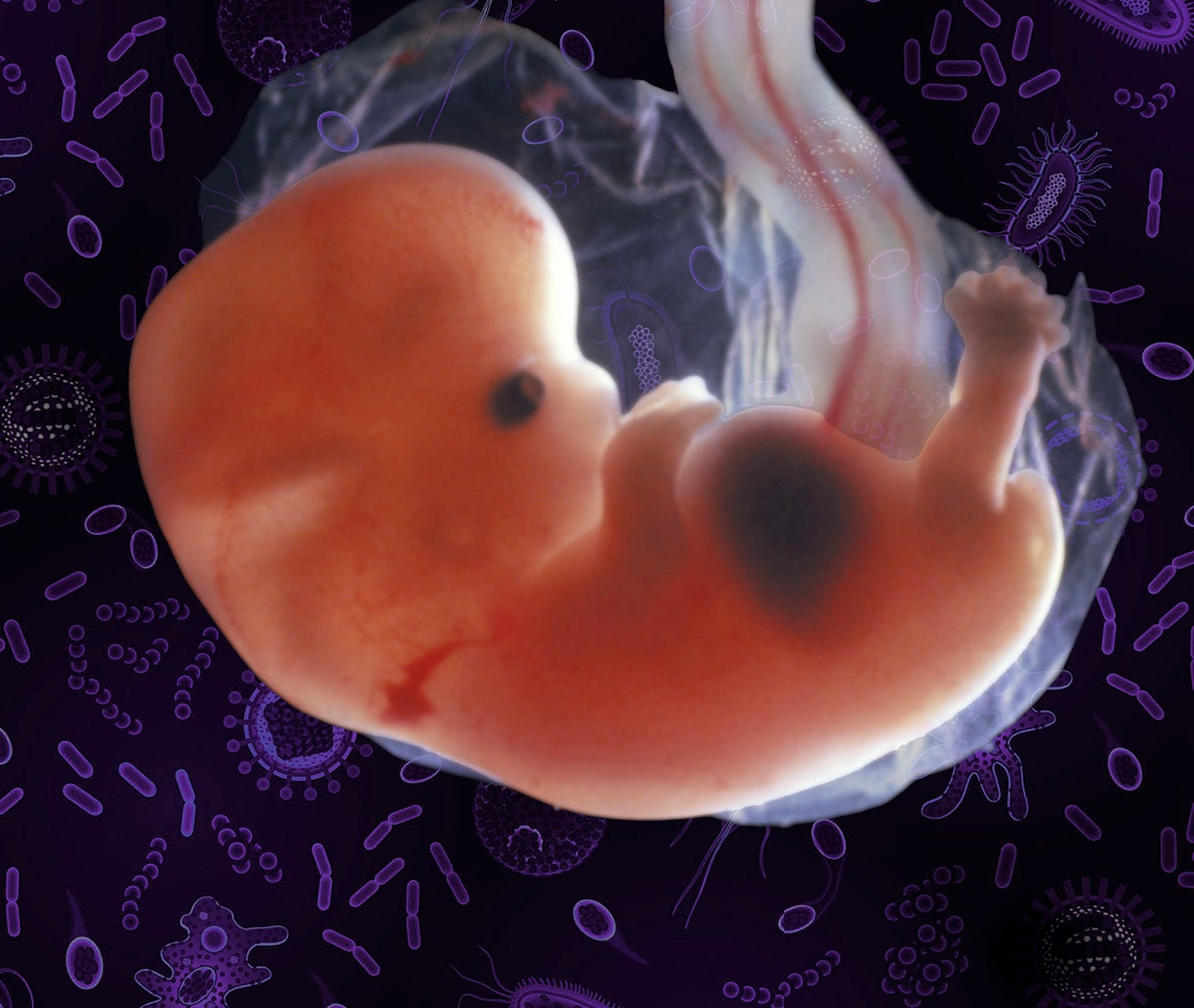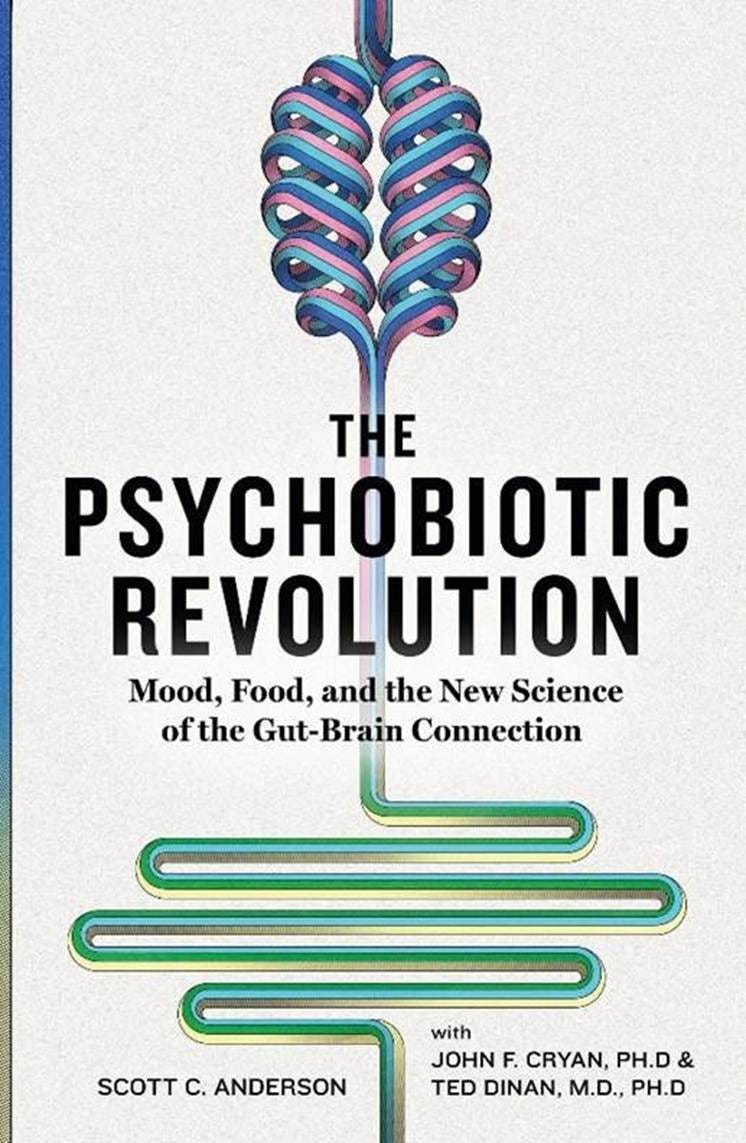Embryos Are Living In a Microbial World
Embryos are full of potential, but very vulnerable. And microbes play a surprising role.
The following is adapted from The Psychobiotic Revolution:
“Is life worth living? This is a question for an embryo not for a man.” —Samuel Butler
We like to think of embryos as little people, but they're not. Early embryos, for instance, have twice the reproductive plumbing, containing both female and male precursors to reproductive organs. Genetically, the embryo is destined to be male or female based on the existence of a Y-chromosome, but physically, the embryo is ready to swing either way. The default is to be female and to let the male structures wither and dissolve. Only the presence of a sex gene from the Y-chromosome will reverse this scenario and dissolve the female structures instead.
Until then, babies have the plumbing for both sexes. From a biological perspective, babies are hermaphrodites for the first two months of their life. To complicate things further, on rare occasions, a baby with a Y-chromosome will have female features. Nature does not get hung up on strict demarcations and sexuality is not as clear-cut as most people think.
How this plays out may be important to your future mental health. Many mental issues, from depression and anxiety to autism, have a sexual bias. Men are four times as likely to have antisocial personality disorders or autism, while women are almost twice as likely to have depression. These gender differences are poorly understood, but they clearly have a big impact on the brain.
Meanwhile, at this stage of pregnancy, the mother's gut microbiota is changing to accommodate feeding extra people. Remarkably, these changes look a lot like metabolic syndrome, inducing weight gain and insulin resistance. Between the first and third trimester, the number of bacterial species drops and those that remain seem to favor putting on fat. This means that there must be some kind of mechanism that prods the gut microbiota toward sucking extra energy from food in order to take care of the baby. It's not too hard to imagine that the same mechanism, started at the wrong time, could lead to obesity, gut dysbiosis and even Type 2 diabetes.
SIDEBAR: Some microbial history
Steaming hot microbes
At an early point in the development of life, deep in a hot sea vent near bubbling volcanic plumes, bacteria that could eat and metabolize sulfur started to thrive. With plentiful sulfur, they could bloom and fill the surrounding sea with their descendants. In such an environment, if another creature was able to strike up a partnership to provide some protection in return from some sulfurous bacterial energy, it was easy to do.
Unlike modern animals that bequeath a healthy microbiota to their offspring, these creatures of the deep never want for partners. The opportunities for freelance arrangements are abundant.
But certain deep sea clams struck up a more intimate relationship, hosting bacteria in the follicles surrounding their eggs, as well as in the eggs themselves. That provided a straightforward way to ensure a microbial legacy. When these clams hatch, their bacteria move throughout the developing body, dividing along with the clam cells. Ultimately they concentrate in the gills, where the microbes pull energy out of the hot sulfurous water and share it with the clam.
Thus empowered, life was able to spread out of the deep ocean vents. The methods of the clam were refined and adopted by other species. And as the relationships became more exclusive, the bacteria evolved, losing some of the survival talents of their untethered brethren. Slowly and surely, the interdependence of animals and bacteria solidified, and they have been intertwined ever since.
Did viruses create mammals?
It’s not just bacteria that have forged bonds with animals. Some 85 million years ago, a virus called syncytia started making the rounds. The virus implanted its own genes into the chromosomes of some ancient proto-anteater, sneaking them in like cuckoo's eggs, hoping to fool the animal cell into tending to its progeny. This virus can drill through cellular membranes, as do many viruses, but this one makes a hole big enough to join up neighboring cells. Essentially, the virus was fusing cells together.
This fusion of cells is not unique in the animal world: muscle cells fuse after exercise to form larger cells with many nuclei. But one of these virally fused cells landed in the reproductive system and ended up in the uterus where it created a kind of padding between the mother's uterine wall and an embryo. This was a prototype placenta.
Because the virus insinuated itself into a reproductive cell — most likely a sperm — it hit evolutionary pay dirt. Every animal descended from that primitive anteater was forever changed. The fact that humans are placental animals is thus down to an early infection by a tiny virus that changed the world.
Back to our baby
For the next eight or nine months, the baby incubates, feeding on maternal blood containing immune cells and antibodies – and possibly exposed to a weak microbial soup.
Mysteries abound about the extent of the bacterial inoculation in these early stages of human development. Exactly how much exposure the baby gets to microbes and what kind of microbes they are – even whether they are beneficial or pathogenic — will be discovered by new research over the next few years. Much of it will be indirect knowledge, because performing experiments on healthy babies is understandably off limits.
The idea that beneficial bacteria could be passed down by mothers is shocking to many doctors and scientists, who have long held that any microbes associated with embryos are universally pathogenic and can result in preterm birth, with all its attendant dangers.
Yet researchers keep finding microbes wherever they look. Investigators have found evidence of bacteria in the umbilical cord, amniotic fluid, fetal membranes and the meconium – the baby's first poop. The microbes in these studies were discovered in completely normal, uninfected babies, although the results are still somewhat controversial.
This is a possible indication that, before the baby is even born, the mother has passed on at least some of her microbiota and likely some of her built-in immunity. That immunity has been sharpened through the generations and honed in the mother to tolerate commensals and fight pathogens. A failure to pick up this worldly knowledge can lead to a haywire immune system causing inflammation and autoimmunity that may plague the baby into adulthood. A smoothly operating immune system is the surest way to avoid depression and anxiety, so choose your mother well.
Stay tuned for the next segment, when we find that gestation pays off with a pretty messy birth.
References
Koren, Omry, Julia K. Goodrich, Tyler C. Cullender, Aymé Spor, Kirsi Laitinen, Helene Kling Bäckhed, Antonio Gonzalez, et al. “Host Remodeling of the Gut Microbiome and Metabolic Changes during Pregnancy.” Cell 150, no. 3 (August 3, 2012): 470–80. doi:10.1016/j.cell.2012.07.008.
Funkhouser, Lisa J., and Seth R. Bordenstein. “Mom Knows Best: The Universality of Maternal Microbial Transmission.” PLOS Biol 11, no. 8 (August 20, 2013): e1001631. doi:10.1371/journal.pbio.1001631.
Jimenez E, Fernandez L, Marin ML, Martin R, Odriozola JM, et al. (2005) Isolation of commensal bacteria from umbilical cord blood of healthy neonates born by cesarean section. Curr Microbiol 51: 270–274. doi: 10.1007/s00284-005-0020-3
Bearfield C, Davenport ES, Sivapathasundaram V, Allaker RP (2002) Possible association between amniotic fluid micro-organism infection and microflora in the mouth. BJOG 109: 527–533. doi: 10.1111/j.1471-0528.2002.01349.x
Rautava S, Collado MC, Salminen S, Isolauri E (2012) Probiotics modulate host-microbe interaction in the placenta and fetal gut: a randomized, double-blind, placebo-controlled trial. Neonatology 102: 178–184. doi: 10.1159/000339182
Jimenez E, Marin ML, Martin R, Odriozola JM, Olivares M, et al. (2008) Is meconium from healthy newborns actually sterile? Res Microbiol 159: 187–193. doi: 10.1016/j.resmic.2007.12.007
This is the bestselling book I wrote with the top two scientists in the field: John F. Cryan and Ted Dinan. They are simply brilliant, and are changing the world one psyche at a time! From National Geographic.




The evolutionary perspective is interesting (to me as scientist), do you think that mammals and live birth, which means the whole complex structure of the placenta, emerged together, or did we have egg-laying mammals (which we still have) first, with the placenta/live birth coming millions of years later?
This is reading like a solid mystery novel. I'm ready for the next instalment!